European Patents Opposed
Since 2018 the EPO has not reported the numbers of patents opposed but based on information in the “Bulletin Search” database that number decreased in 2020. However, the number was still consistent with a general level of patents opposed which is around 25% higher than the more or less uniform level which prevailed from 2011 to 2016. The increased level of patents opposed each year followed, but has by no means kept pace with, increases in the numbers of patents granted.

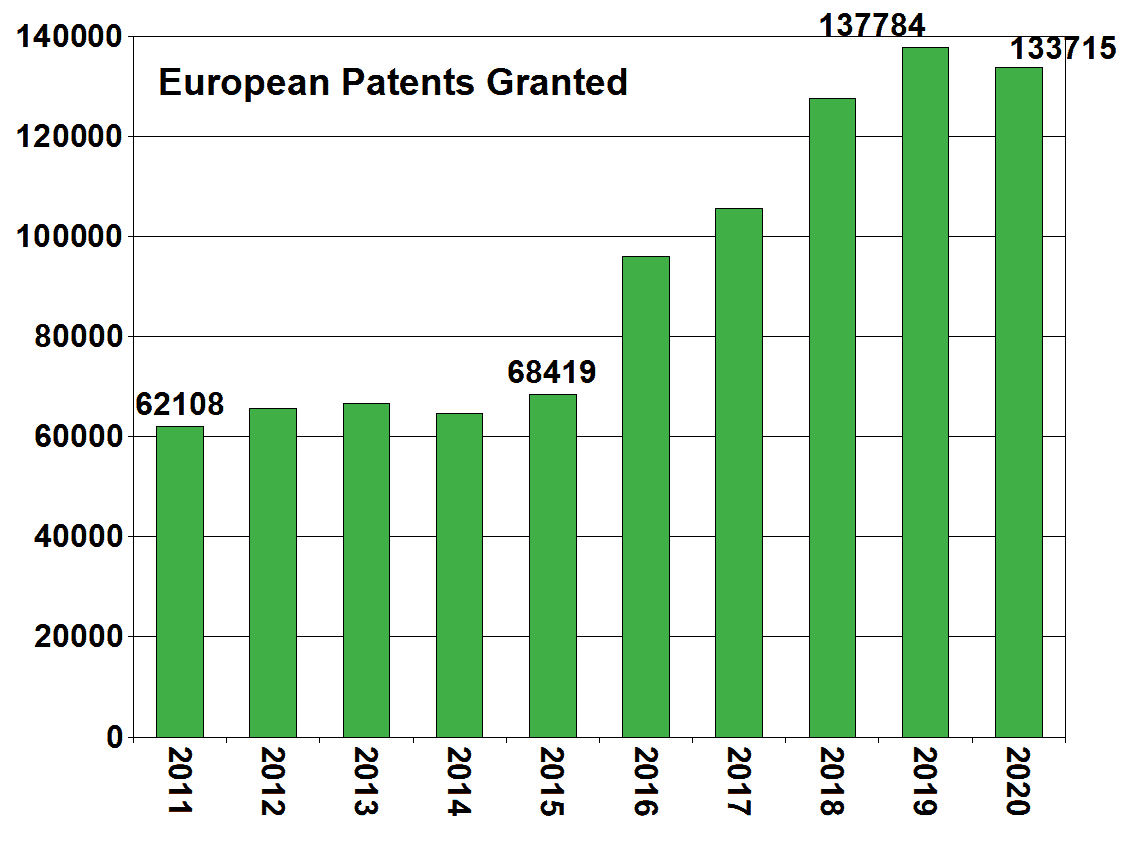
First Instance Opposition Decisions
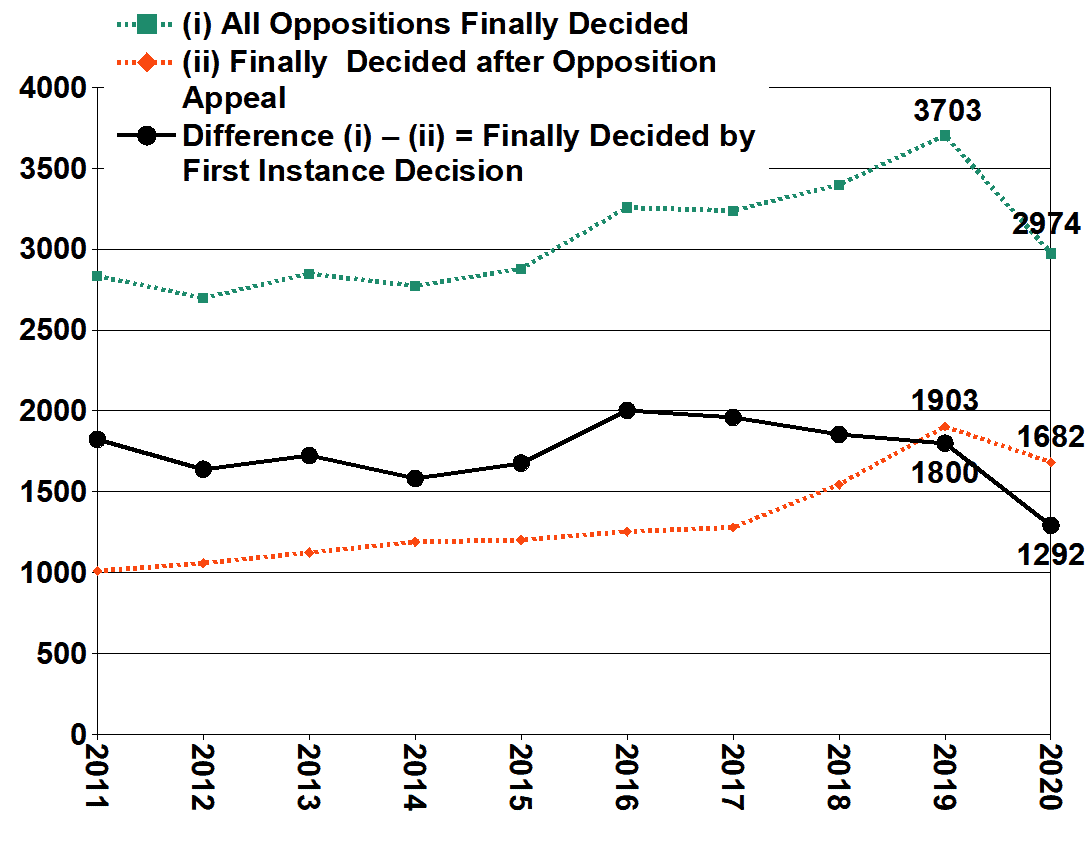
Since 2018 the EPO has not reported on first instance opposition decisions, neither on the number of those decisions nor on
what the first instance outcomes were (e.g. patent revoked; opposition rejected). Unfortunately, first instance decisions are not separately noted in the “Bulletin Search” database, which records only final decisions.
The number of opposition appeals settled each year is indicated in annual reports of the Boards of Appeal and the difference between this number and the total number of final decisions according to the “Bulletin Search” database could indicate a general level of first instance decisions that became final without appeals. This suggests that from 2011 to 2019 around 60% of first instance decisions became final without appeals and in 2020 about 55%.
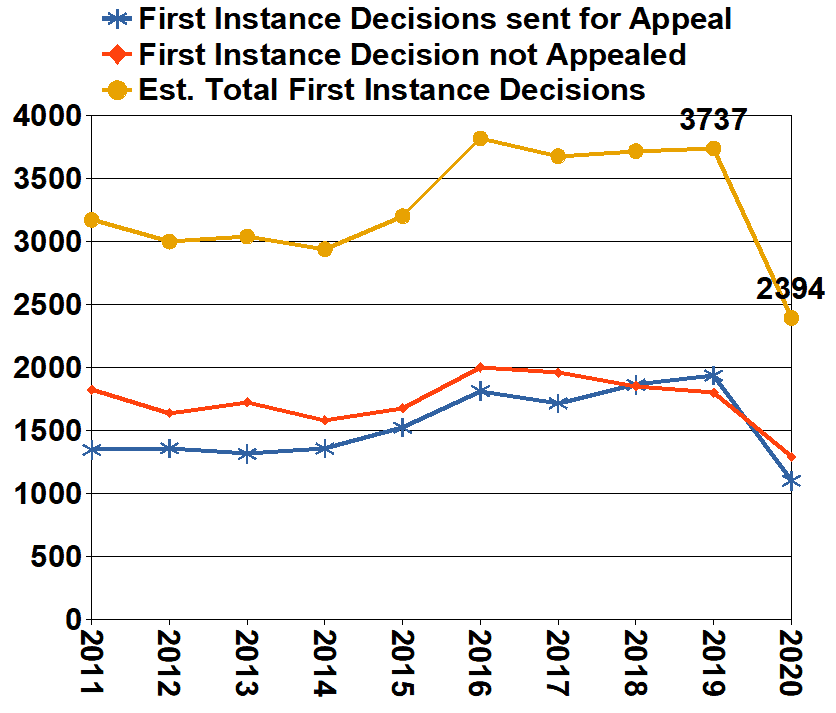
Based on the number of first instance decisions that became final without appeals and the number sent for appeal (according to annual reports of the Boards of Appeal), the total number of first instance decisions might be estimated. This suggests that there was a very significant fall, by more than one third, in the number of first instance opposition decisions in 2020, a year in which the COVID-19 pandemic presented the EPO with significant challenges.
Final Outcomes of Oppositions
According to the “Bulletin Search” database, in 2020 just under 3000 opposition decisions became final, significantly fewer than in 2019. It seems clear that both first instance Opposition Divisions and the Boards of Appeal faced considerable difficulties as a result of the pandemic, such as difficulties in holding oral proceedings. In 2020, the final outcome “(i) patent revoked” was less common than the outcome “(ii) patent maintained in amended form” (“patent amended”), with “(iii) opposition rejected” even less common. Other possible outcomes (iv) e.g. opposition inadmissible or opposition proceedings terminated (for instance if the opposition is withdrawn) were relatively infrequent.
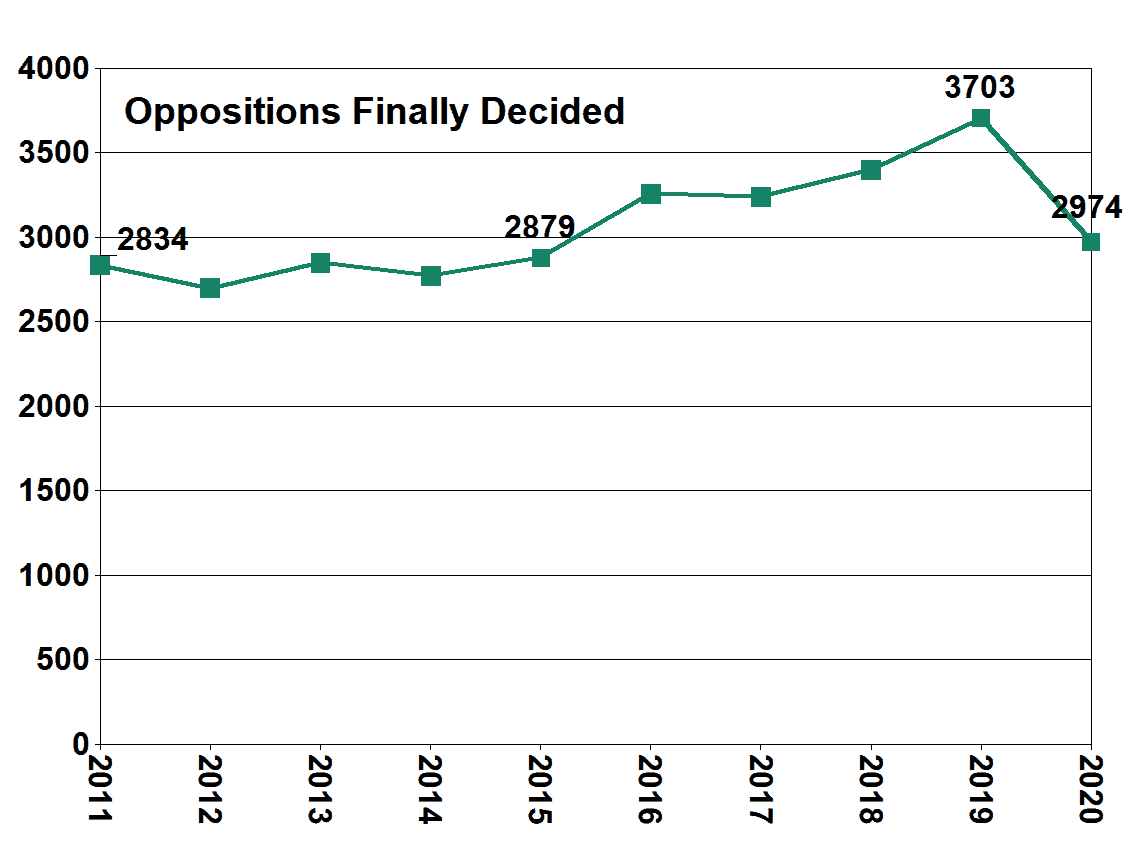
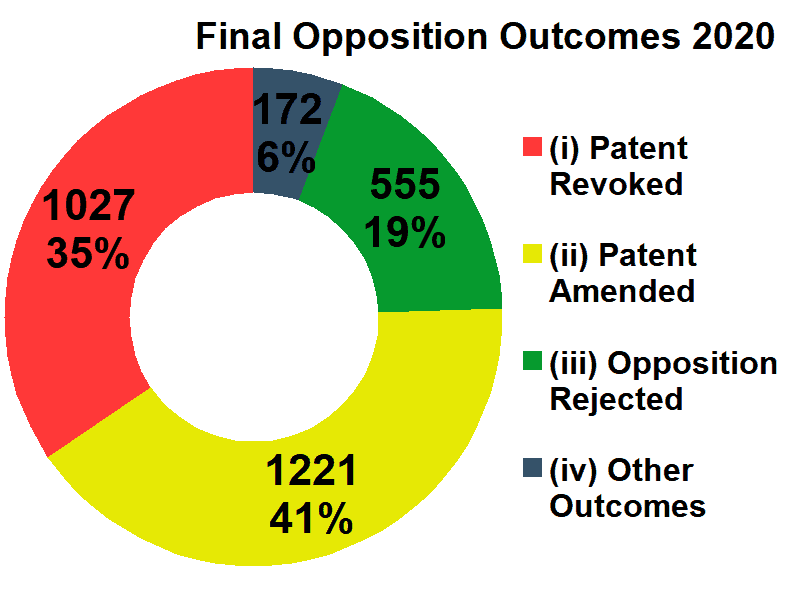
2020 was clearly an exceptional year as a result of the pandemic, probably providing no insight into any ongoing trend in final opposition outcomes. However, up to 2019 the balance between different final opposition outcomes had changed over time. In 2011, “(i) patent revoked” was the most common final opposition outcome by some margin. By 2019, “(ii) patent maintained in amended form” (“patent amended”) was an equally likely outcome. The likelihood of the outcome “(iii) opposition rejected” (patent maintained as granted) increased from 2011 to 2018 but fell back somewhat in 2019.
Together, “(i) patent revoked” and “(ii) patent maintained in amended form” (“patent amended”) account for around 70% of final outcomes, fairly consistently from 2011 to 2019: in over two thirds of opposition proceedings the final outcome eliminates or restricts the opposed patent. Of course, each restriction resulting from amendment of a patent has to be assessed individually to judge how far it is of real benefit to the opponent, who would aim to guard against amendments which might narrow down but strengthen a patent in a way adverse to the opponent’s interests.
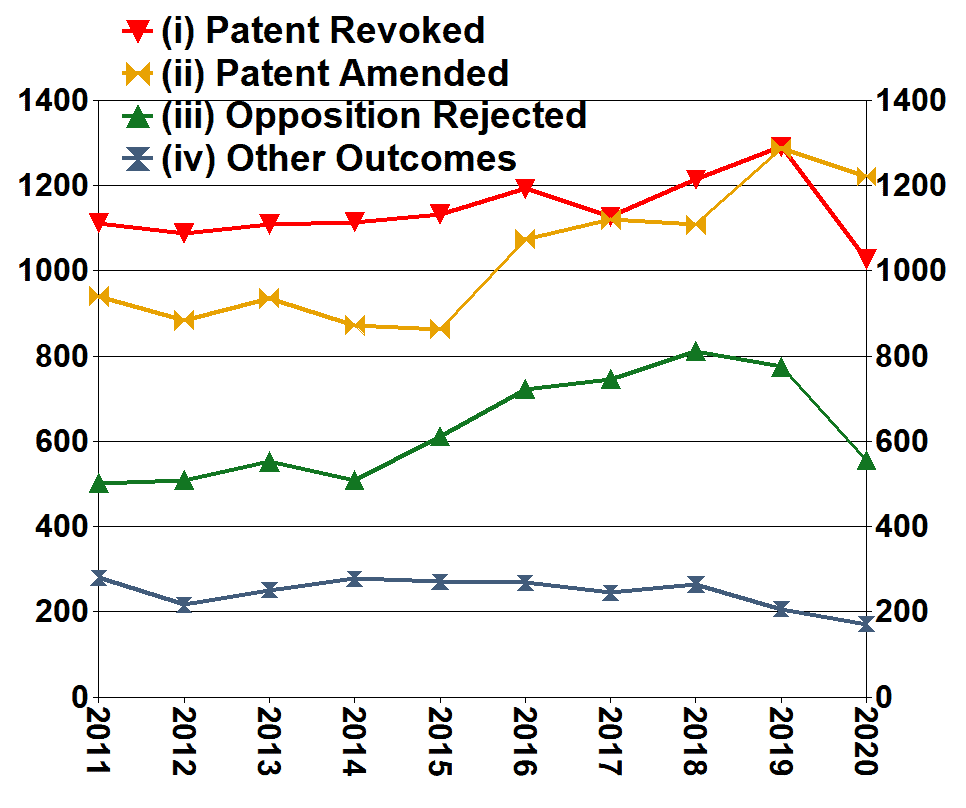
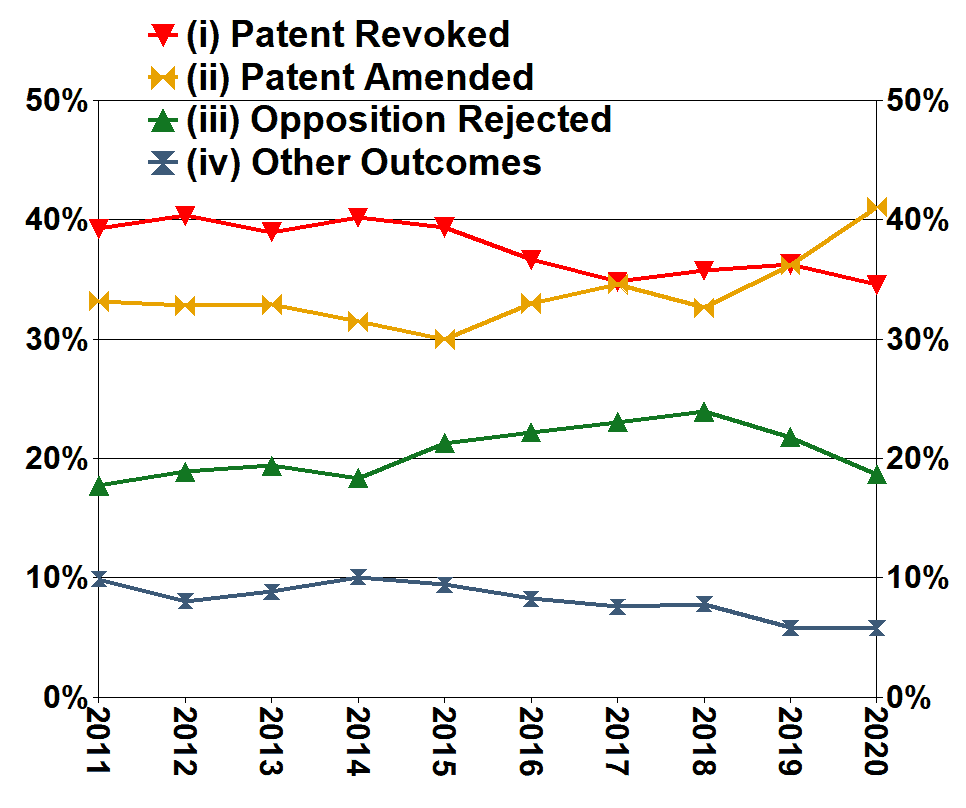
Duration of Opposition Proceedings
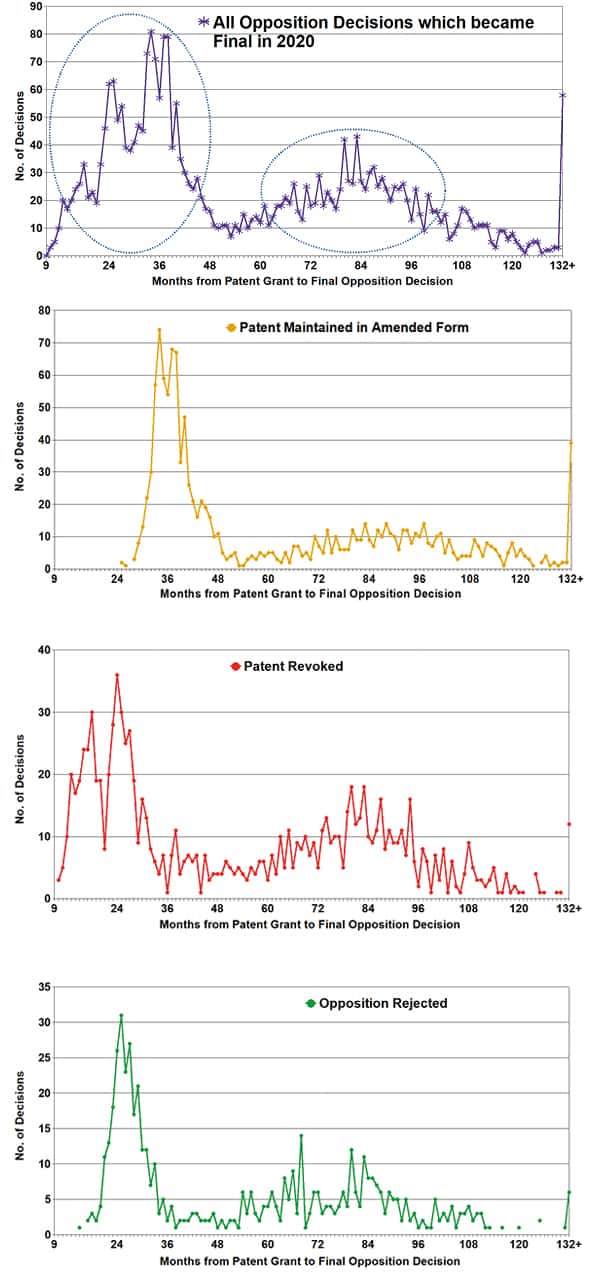 A chart of how long it took to reach all opposition decisions which became final in 2020 has peaks from around 12 to around 36 months and peaks again later at around 84 months. The earlier peaks are taken to correspond to first instance decisions by EPO opposition divisions which became final with no appeal entered and the later peak to correspond to cases in which final decisions were made by Boards of Appeal.
A chart of how long it took to reach all opposition decisions which became final in 2020 has peaks from around 12 to around 36 months and peaks again later at around 84 months. The earlier peaks are taken to correspond to first instance decisions by EPO opposition divisions which became final with no appeal entered and the later peak to correspond to cases in which final decisions were made by Boards of Appeal.
The peaks from around 12 to 36 months are believed to be due mainly to a difference between “patent maintained in amended form” (“patent amended”) decisions and decisions of “patent revoked” or “opposition rejected”. After pronouncement of a decision “patent maintained in amended form”, formal procedures must be completed for publication of the amended patent before the decision becomes final. These procedures take a number of months and the decision becomes final only as of the date of publication of the amended patent. In contrast, “patent revoked” and “opposition rejected” decisions become final as of the date they are pronounced. This is illustrated by the further charts.
The charts also suggest that around 55% of final decisions in 2020 became final without appeal. This may suggest that Opposition Divisions faced more difficulties in processing cases, due to the pandemic, than did Boards of Appeal.
Patentees & Opponents 2020
The approx. 3200 patents opposed in 2020 belonged to around 1700 different patentees (it is difficult to state a definitive number since this depends on how related but legally distinct companies are counted, how joint patentees are counted and not least on how variations in naming of patentees are recognised and assessed). The 40 patentees that attracted the most oppositions are indicated in the first table below. These 40 patentees, about 2% of all patentees, accounted for about 22% of all patents opposed in 2020.
The approx. 3200 patents received around 4400 oppositions filed by around 1600 different opponents (again it is difficult to state a definitive number). The 41 most active opponents are indicated in the second table below (so-called “straw man” opponents are omitted since the parties in whose interests the oppositions are filed are unknown – and the same “straw man” may act for different parties in different cases.) These 41 opponents, about 2.5% of all opponents, accounted for about 22% of all oppositions in 2020.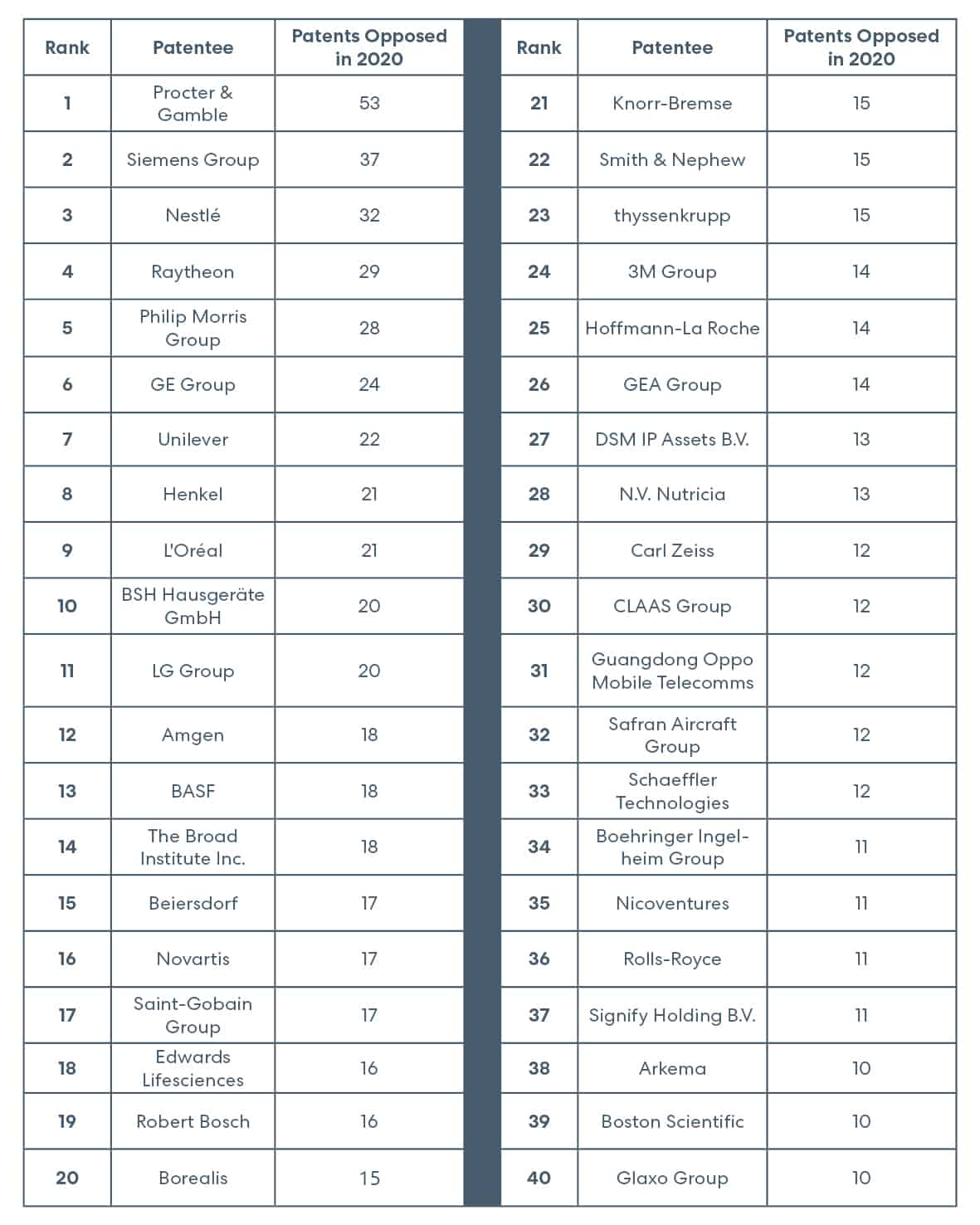
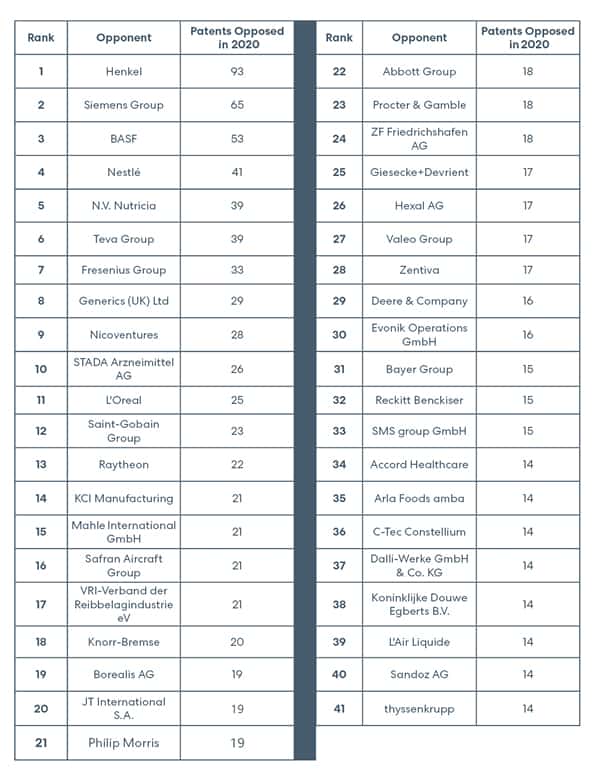
Most Opposed Patents
 In 2020 around 4400 oppositions against 3200 patents means that on average each opposed patent received around 1.35 oppositions. However, by far the majority of patents opposed in 2020 received only a single opposition, around 12% of patents opposed received two oppositions and about 5% of patents opposed received three or more oppositions.
In 2020 around 4400 oppositions against 3200 patents means that on average each opposed patent received around 1.35 oppositions. However, by far the majority of patents opposed in 2020 received only a single opposition, around 12% of patents opposed received two oppositions and about 5% of patents opposed received three or more oppositions.
The table below lists the patents which received the most oppositions in 2020. Patents concerned with pharmaceuticals dominate the table.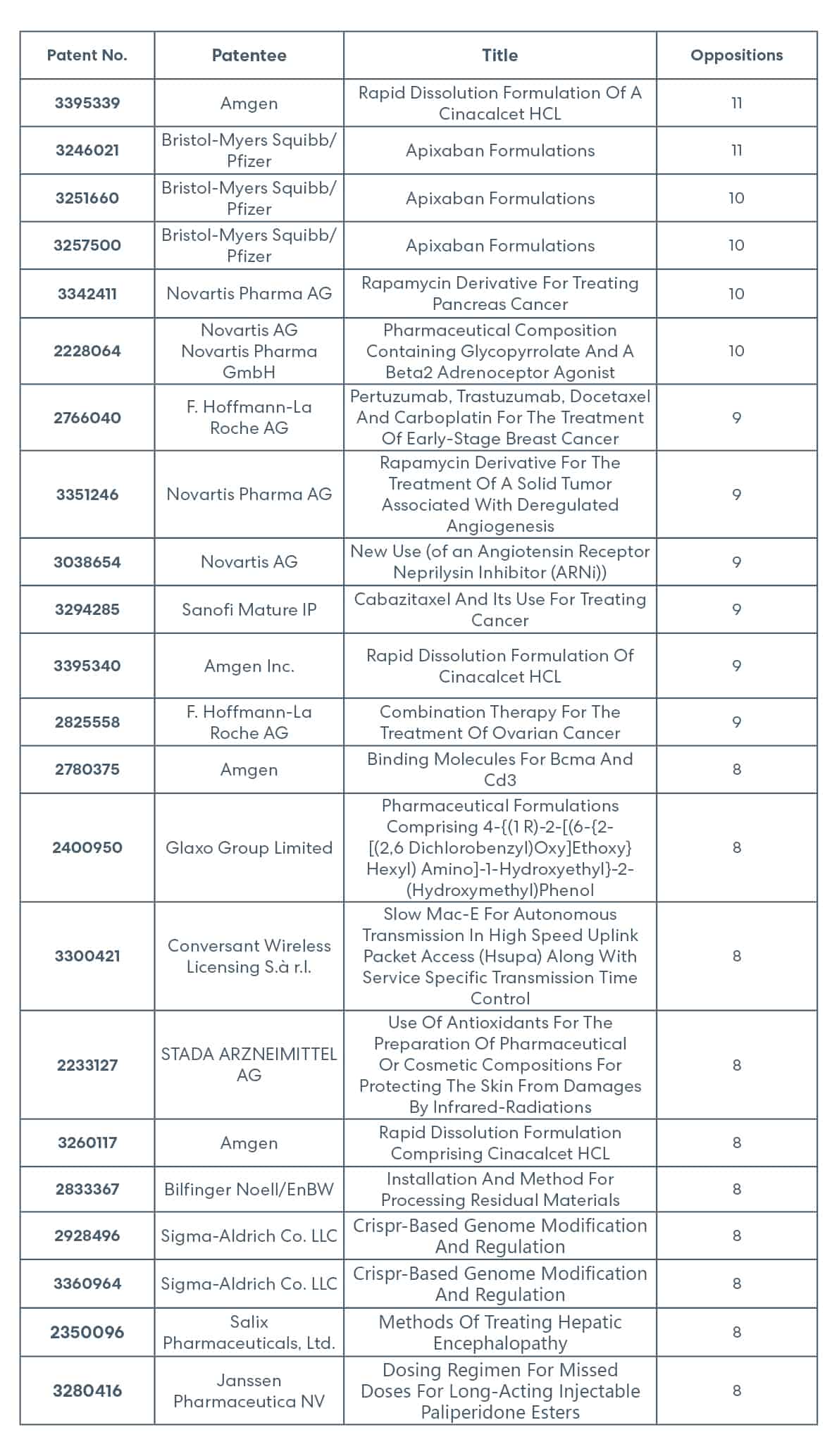
Technical Fields of Opposed Patents
Conspicuous by their absence from tables of most opposed patentees and most active opponents are electronics, computer and telecommunications companies which are some of the top applicants in terms of numbers of European patent applications filed and top patentees in terms of numbers of European patents granted. The table below illustrates that the distribution of technical fields of patents opposed in 2020 does not conform to the distribution of technical fields of all patents granted in 2020. There are proportionally fewer opposed patents in the general fields of physics and electricity than might be expected from all granted patents, with proportionally more opposed patents in the general fields of chemistry/metallurgy and human necessities. (The percentages in the table do not add up to 100% – patents may be classified as relating to more than one general field).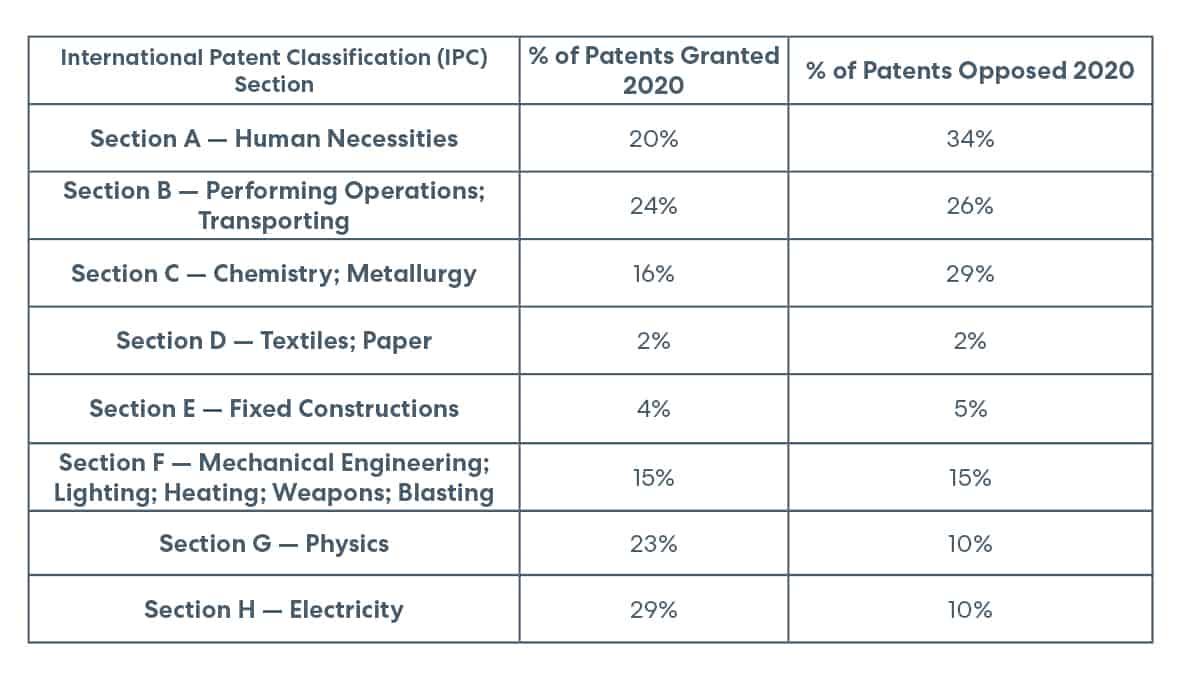 The ca. 3200 patents opposed in 2020 are given at least around 12,000 detailed International Patent Classification (IPC) classifications. These 12,000 detailed classifications fall into around 120 different IPC classes. In terms of IPC classes the ten within which the greatest number of those detailed classifications fall are shown in the table below. The class A61 – Medical or Veterinary Science; Hygiene – is by far the most common class of patents opposed in 2020, as in previous years.
The ca. 3200 patents opposed in 2020 are given at least around 12,000 detailed International Patent Classification (IPC) classifications. These 12,000 detailed classifications fall into around 120 different IPC classes. In terms of IPC classes the ten within which the greatest number of those detailed classifications fall are shown in the table below. The class A61 – Medical or Veterinary Science; Hygiene – is by far the most common class of patents opposed in 2020, as in previous years.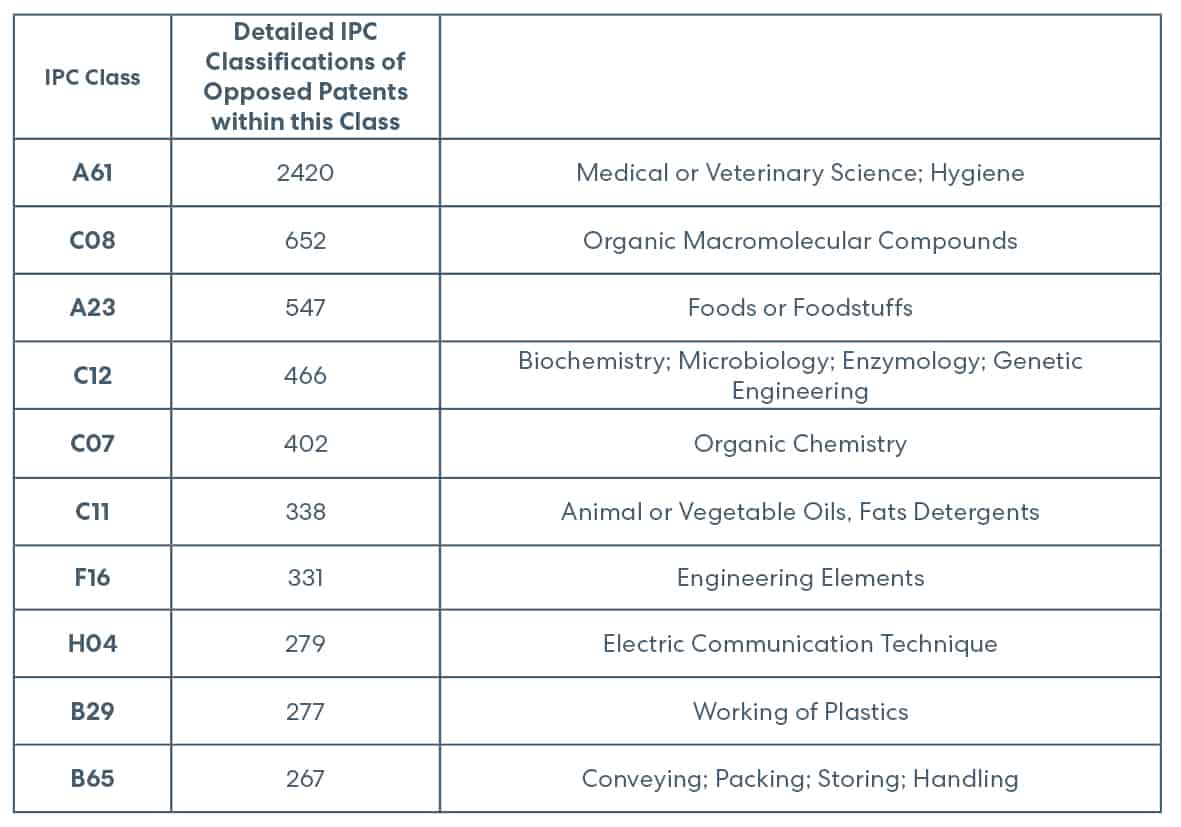
This is for general information only and does not constitute legal advice. Should you require advice on this or any other topic then please contact hlk@hlk-ip.com or your usual Haseltine Lake Kempner advisor.